
Children's Book Ideas: 4 Ways to Generate New Ones
- by Myrna Foster
- published
Are you looking for fresh, exciting children's book ideas?
There are a lot of ways that you can coax an idea into being. I'm going to share four of my favorite ways to generate new picture book ideas.
Children's Book Idea Generators
Idea Generator #1: Listening to Children
If you have children, work or volunteer with children, you know they say (and do!) some interesting things. Writing those things down can lead to ideas. One important component of any good children's book idea is to make it kid relatable. What is more kid relatable than a real life situation from a real life kid?!?
Idea Generator #2: Tapping Childhood Emotions
Journaling about emotional (triumphant, devastating, funny, frustrating, embarrassing, etc.) experiences from your own childhood can spark an idea. Did something come to mind while you were reading those emotions? If so, write about what happened and how it made you feel. Then come back to this post when you're done.
Idea Generator #3: Arree's Post-it Note Exercise
You'll want to come up with lots of children's book ideas, not just one. Often, our first ideas are not our best ones, but write them down anyway. If you ask “What if . . .?” enough times, you can turn a ho-hum idea into something extraordinary.
And on that note, I have Arree's permission to share the Post-it Note Exercise that he teaches students in his Crafting Picture Book Stories class. This exercise is a combination of collage, brainstorming, and mind mapping that always yields rewarding “Aha!” moments when I take the time to do it. Arree said it's fun to do it with friends. If you have kids, I recommend doing it with them.
Plan on the exercise taking you at least an hour.
POST-IT EXERCISE INSTRUCTIONS:
Materials Needed:
- Post-its (lots)
- Pens
- A timer
- Friends or children (optional but more fun)
- A wall or place work on
Brainstorming Steps:
- Get out a timer and set it for 10 minutes. Start the timer.
- First, we're going to brainstorm characters. Write down one word that describes the character. For example: “Toast” or “Alligator.” Think of more than just animals, include objects like cars, flowers or coaches.
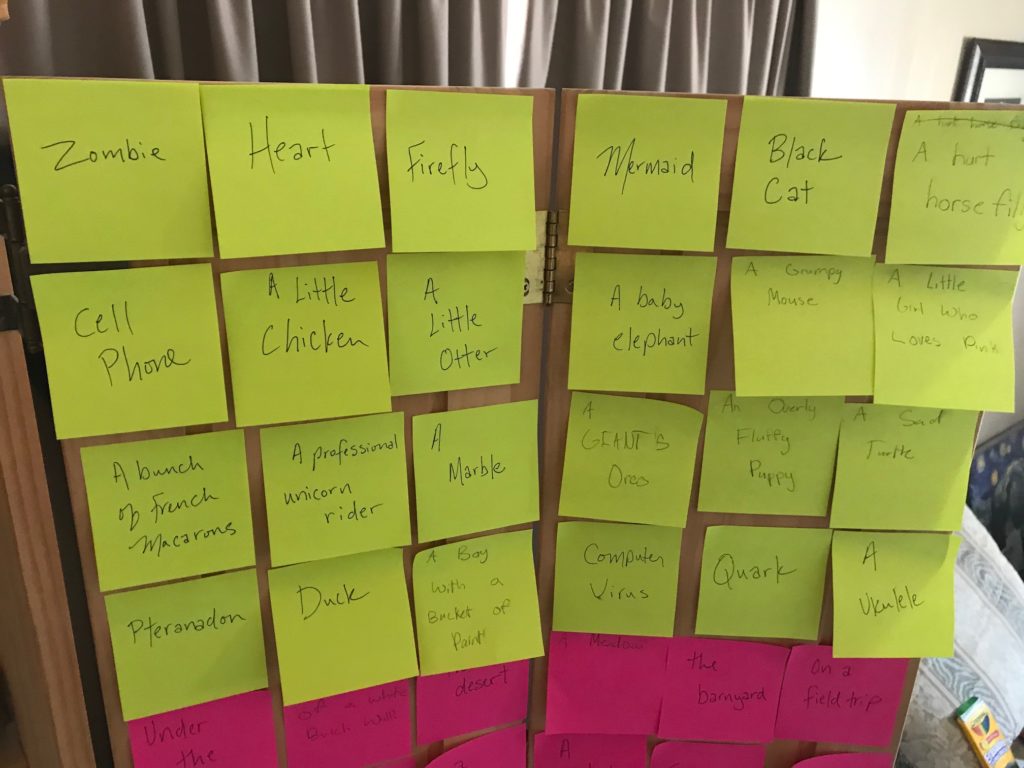
3. Write down one character on each post-it. You can draw on the post-it if you'd like.
4. Brainstorm as many characters as you can in 10 minutes. (If you need more time, you can do another 5 minutes.)
(OPTIONAL: Repeat steps 1-4, but this time brainstorm character names. Think of names that are unique or have some kind of feeling to them.)
Repeat steps to brainstorm places. What are some of your favorite places? Are there places a child might want to explore through a story?
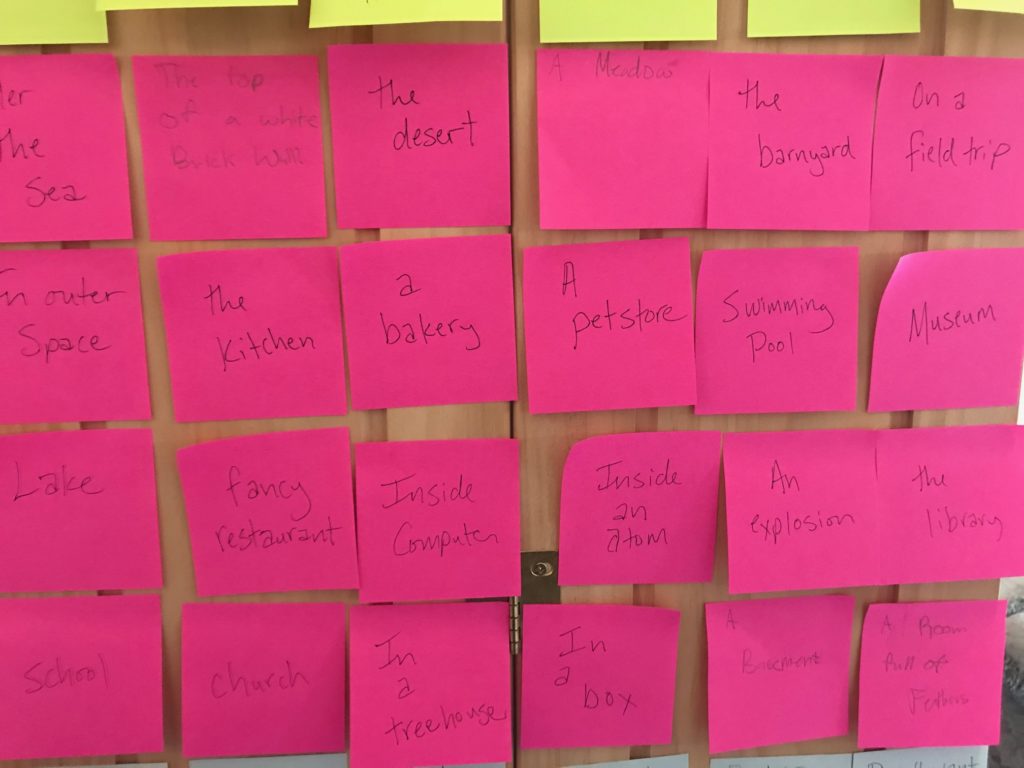
Repeat steps 1-4 to brainstorm problems that characters may have. For example: not getting what you want, being lost, feeling sad, misunderstood, etc.
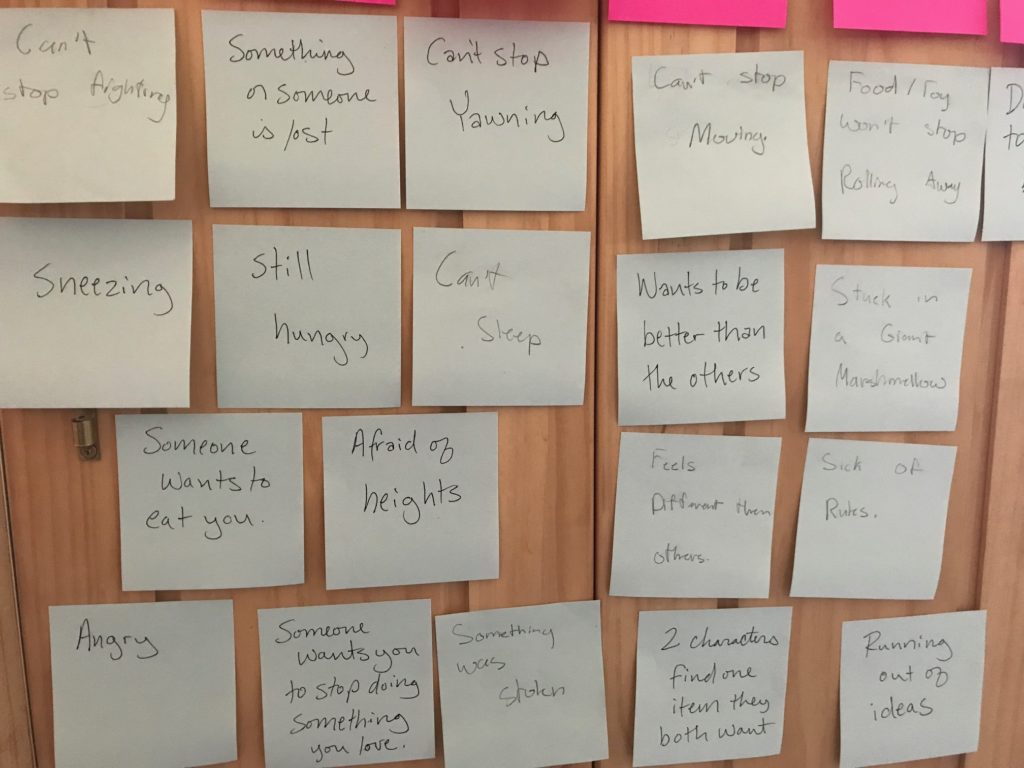
Collage Steps:
- Place all the post-its on a wall. Group the post-its together by category.
- Overlap the same/similar post-its together. For example, if you wrote “rat” and someone wrote “mice,” you can place those two characters together.
- Take a step back and look at the whole wall. Let your mind wander while reading the post-its.
- See if you can “collage” together some interesting story concepts. This is usually a fun step.
- Reserve judgment that might hold you back. Just go with your gut instincts on what feels good.
- Once you have an idea for a story, group the post-its together.
- Fill in the missing GAPS. Write down the inciting incident, the escalation, and the resolution on post-its as they come to you. (Fun, right?)
- Make as many story sketches as you can. Don't be judgmental yet. Make as many story ideas as you can.
- Pick your favorites and take a picture of them.
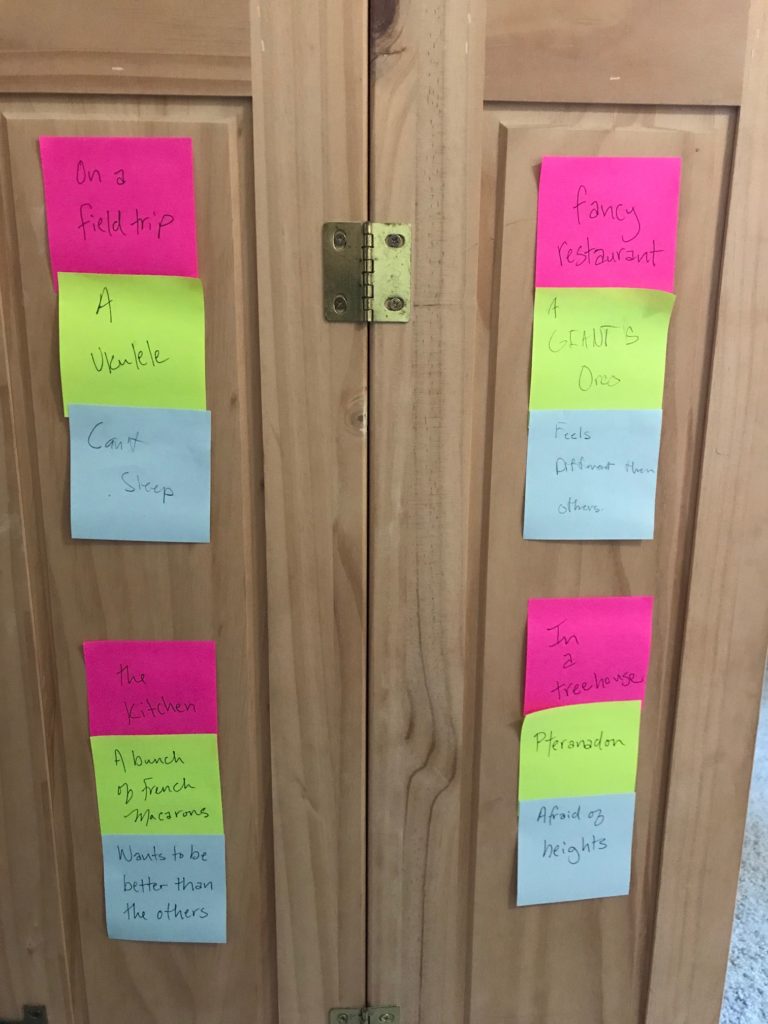
Mind Mapping Steps:
- CHARACTER:
- PLACE:
- PROBLEM:
- INCITING INCIDENT:
- ESCALATION:
- PEAK:
- THE MAIN IDEA:
- IT-FACTOR:
- IS IT APPEALING?
I'm going to leave those blank to make it easy for you to copy and paste them into a doc to flesh out your own ideas. But just in case you don't know what the terms mean, I'm going to walk you through mapping one of our ideas.
Example:
- CHARACTER: Ukulele
- PLACE: On a field trip
- PROBLEM: Ukulele wants to finish his nap, but the teacher keeps waking him up to play more verses of a song for the kids on their field trip.
- INCITING INCIDENT: The teacher pulls him out of his case for an Old MacDonald sing-along.
- ESCALATION: He's so sleepy that he can't keep his strings in tune. The teacher plays and sings a new verse every time they meet a new farm animal.
- PEAK: He does his best, even though he's sleepy, and the kids love it. It resolves with him going back in the case to finish his nap.
- THE MAIN IDEA: This story uses interactive elements and humor to show that doing hard things can be worth the effort.
- IT-FACTOR: Sing-along and animals
- IS IT APPEALING? I think it could be. I'll need to write it to see if it works, but I know from teaching preschool that kids like singing along and predicting what comes next.
And that's it! I hope you give Arree's Post-it Note Exercise a try.
Idea Generator #4: Reading Storystorm Blog Posts
If you've never participated in Tara Lazar's Storystorm challenge, then I'm excited to introduce you to my favorite blog for generating children's book ideas. The whole concept behind Storystorm is to come up with a bunch of story ideas in January that you can write throughout the year. Since we're coming to the end of a post on generating ideas, I'm going to link to Debbie Ridpath Ohi's metaphorical post on how developing an idea is like baking a cake. This post is so good that Tara has shared it twice! It might help you figure out what to do next. Tara has hundreds of wonderful posts by successful industry professionals on her blog.
Good luck with your children's book ideas!

Myrna Foster
Myrna Foster writes and edits content for Storyteller Academy and the WriteRiders Newsletter for SCBWI Nevada. She has spent a lot of time teaching and coaching children, including five years as a preschool teacher. She's also worked as a journalist, and Highlights High Five has published six of her poems.
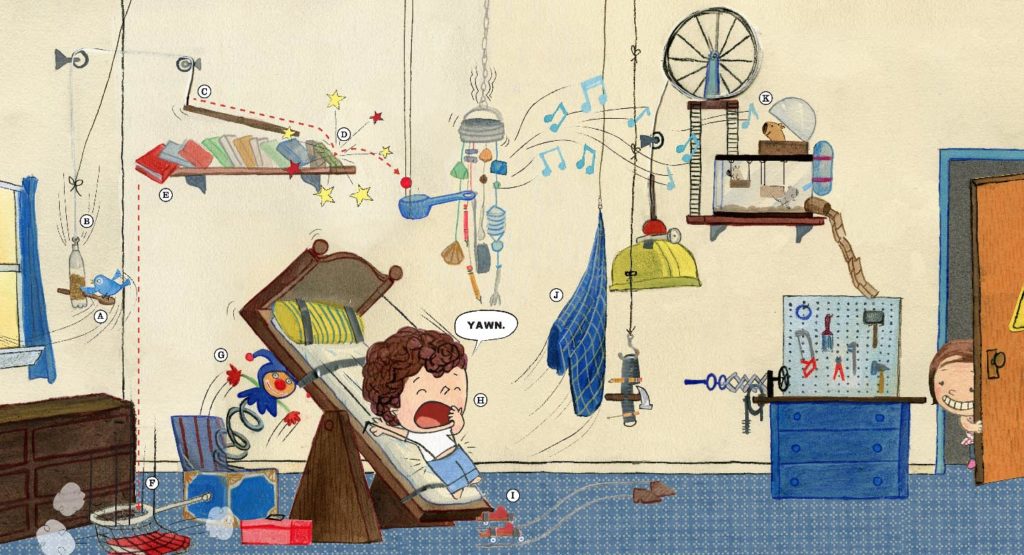
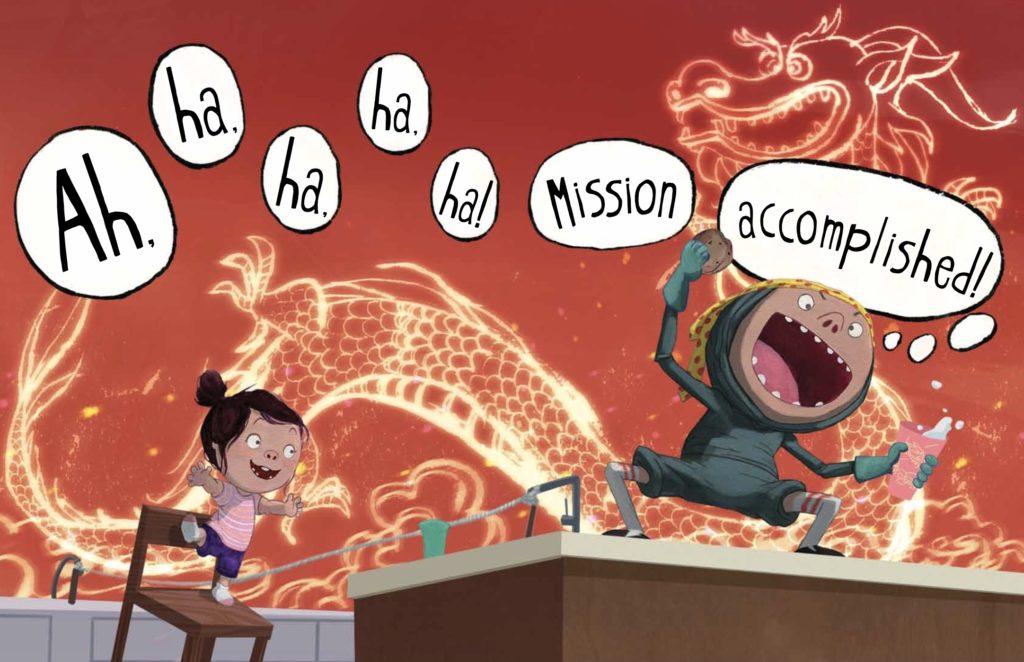
FREE DOWNLOADABLE RESOURCES
Find them HERE

Learn how to write your children's book from professional, award-winning authors and illustrators
in your own time, at your own pace.
JOIN OUR COMMUNITY
Your creative village is waiting for you HERE.
And it's free!
FEATURED

How to Write Children's Books in 7 Steps
EXPLORE
RECENT POSTS
Guest Post: Charlotte Watson Sherman
Instructor Stories: Darcy Pattison
Instructor Stories: Baptiste Paul
Instructor Stories: Isabella Kung
Challenges & Twitter Events for Kidlit Creators
Use Mentor Texts to Write Chapter Books

